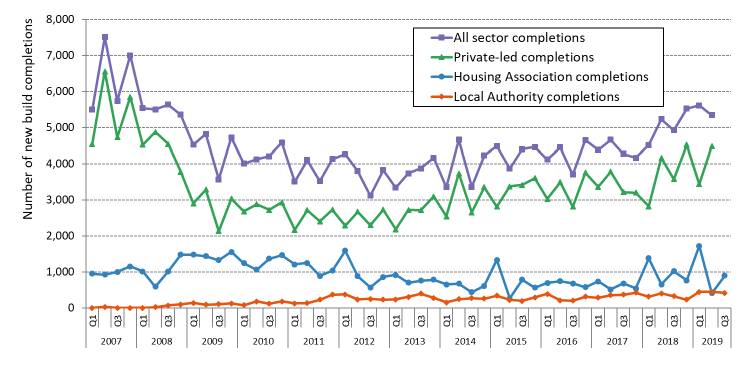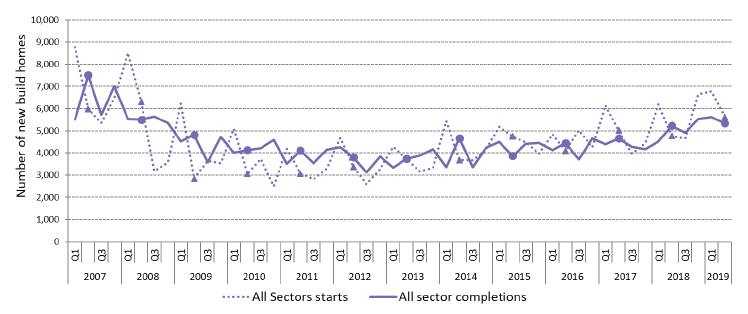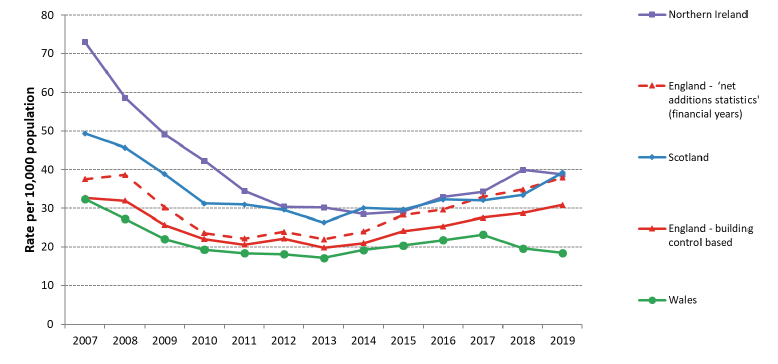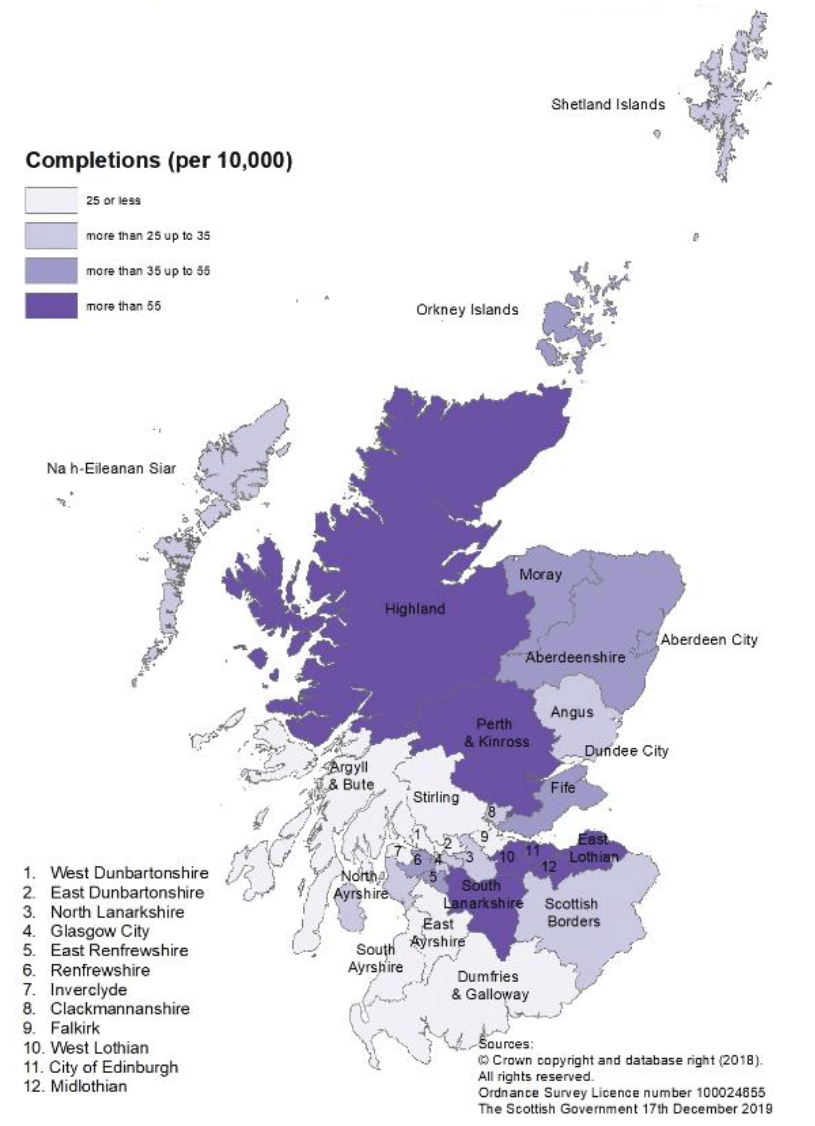Housing statistics quarterly update: December 2019
Trends in new build housing starts and completions by sector, and the Affordable Housing Supply Programme.
New Build Housing – All Sectors – up to end June 2019
The new-build section of this document provides figures on the number of homes started (when the foundations are begun) and completed (when a building inspector deems the property complete).
Figures are presented for homes built on privately led (referred to throughout as private sector), local authority led (referred to as local authority sector) and housing association led (referred to as housing association sector) sites. For the private sector the latest information available is for the quarter ending June 2019. Whilst more up-to-date information is available for local authority and housing association new builds, findings for these sectors are mainly presented up to June 2019 to simplify comparisons between sectors.
The figures have not been seasonally adjusted and so commentary tends to compare the latest quarter with the same quarter the previous year. To help with this, Quarter 3 figures (from July to September) have been highlighted in the charts to allow easy comparison over time. Some of the peaks in the number of starts in Quarter 1 each year are due to large numbers of housing association approvals being granted near the end of the financial year.
Trends since 2007 – all sectors
Chart 1 (see page 1) shows that annual all-sector new build starts and completions (years to end June) have both shown a broadly increasing trend since 2013. In the latest year, starts and completions have increased by 22% and 18% respectively, and are now approaching levels last seen in 2007 and 2008.
Chart 2 presents new build completion trends on a quarterly basis and by sector, which shows the impact of the recession in the second half of the last decade, with private sector led completions falling throughout 2008 due to the financial crisis.
Chart 3 presents quarterly trends in all-sector starts and completions, which are generally showing an upwards trend since 2013, with marked increases over the last 5 quarters.
Chart 2: Quarterly new build completions show a marked increase overall over the latest five quarters, although as with earlier time periods, figures for individual quarters can show some volatility over time

Chart 3: Quarterly new build starts and completions across all sectors show a generally upward trend since 2013, but with some quarterly volatility evident, particularly for starts

Trends to end June 2019 – all sectors
There were 5,342 new build homes completed between April and June 2019; a 2% increase (111 homes) on the same quarter in 2018. This brings the total for the year to end June 2019 to 21,403, up 18% (3,210 homes) compared to the 18,193 completed in the previous year.
There were 5,620 new build homes started between April and June 2019, 18% more (857 homes) than the same quarter in 2018. This brings the total for the year to end June 2019 to 23,700 which is up 22% (4,340 homes) compared to the 19,360 homes started in the previous year.
Comparison with the rest of the UK from 2007 to 2019 – all sectors
Each of the countries of the UK produces their own statistics on quarterly new build housing starts and completions by tenure, and all use broadly consistent definitions. These new build statistics for each of the countries of the UK, as well as for Great Britain and the UK as a whole can be found here: https://www.ons.gov.uk/peoplepopulationandcommunity/housing/datasets/ukhousebuildingpermanentdwellingsstartedandcompleted.
In addition to this, the Ministry of Housing, Communities and Local Government (MHCLG) also produces an additional annual set of statistics for England on new build homes, as a component part of the ‘Housing supply; net additional dwellings, England’ set of statistics[1]. These statistics are collected on a different basis to the quarterly UK country statistics as local authorities can use a range of data sources to collate these figures rather than solely using building control information. Figures on this for 2018/19 were published on 03 October 2019, and this publication advised that the ‘net additional dwellings' should be considered the primary and most comprehensive measure of housing supply in England.
MHCLG have advised that the quarterly new build statistical collection for England, whilst being a useful leading indicator of activity throughout the year, is not currently capturing all new build activity, largely due to difficulties in collecting accurate starts and completions data from independent building inspectors or where building control has been sourced out to strategic partnerships or the private sector. These data issues do not exist in the Scotland quarterly housing statistics, given that all of the 32 local authorities in Scotland directly manage building control and the associated provision of data to the Scottish Government on starts and completions.
As a result of this advice, the new build component figures of the ‘net additional dwellings' statistics for England are included in the UK comparisons as an additional set of figures to consider when comparing between countries.
Chart 4 presents trends in the rates of new house building per 10,000 population across each of the UK countries. The latest available Ministry of Housing, Communities and Local Government (MHCLG) annual ‘net additional dwelling’ statistics for England indicate that whilst Scotland had a higher rate of completions per 10,000 head of population than England over the period 2007 to 2016, the rate in Scotland was slightly lower than in England during both 2017 and 2018, however that in the latest year Scotland has had a slightly higher rate of completions per 10,000 (39 in Scotland, compared to 38 in England). Note that the ‘net additional dwellings’ are annual financial year figures, i.e. the year to end March, whilst the figures presented for Scotland are for the year to end June.
The 39 homes built per 10,000 population in the latest year in Scotland is similar to the rate seen in Northern Ireland (39 homes per 10,000), and higher than the rate seen in Wales (19 homes per 10,000). Prior to this, the rate in Scotland has been below the rate in Northern Ireland since 2007 apart from 2014 and 2015, but has been above the rate seen in Wales in each year since 2007.
Chart 4: New house building as a rate per 10,000 population (years to end June) - Scotland had a rate of 39 in the latest year, the same as Northern Ireland (39) and higher than England net additions statistics (financial years) (38) and Wales (18)

Sub-national figures for the year to end June 2019 – all sectors
The information on new build housing in Scotland is collected and published at local authority level. Map A, below, shows new house building in the year to end March 2019, as a rate per 10,000 population based on the latest mid-2018 population estimates.
In the year to end June 2019 the highest new build rates were observed in East Lothian, Midlothian, Perth & Kinross, West Lothian and South Lanarkshire. The lowest rates were observed in Dumfries & Galloway, Stirling, Inverclyde, East Dunbartonshire and West Dunbartonshire.
Map A: New build housing - All sector completions: rates per 10,000 population, year to end June 2019

Contact
Email: Felix.Palin@gov.scot
There is a problem
Thanks for your feedback